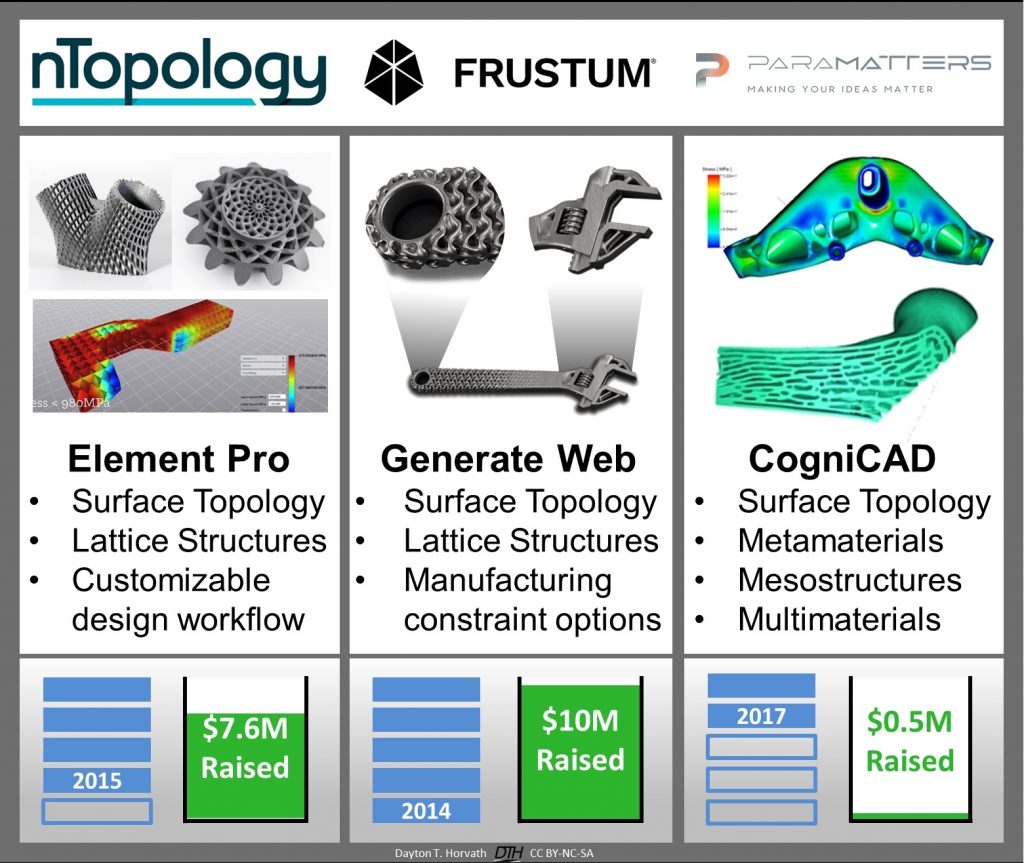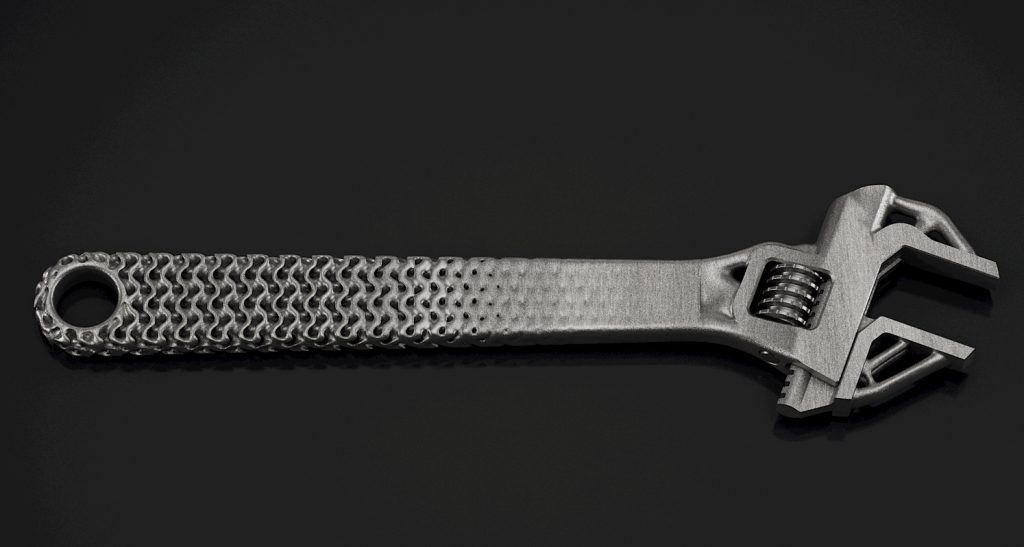Breaking announcements in printable materials, hardware, and the latest end-use applications are now standard at major 3D printing conferences. Focusing on the latest parts designed for additive manufacturing, typical explanations for how each was conceived likely include the terms topology optimization, lattice design, and generative design.
Although these concepts are well established in an academic sense, their commercial implementation and technical definitions have become the focus of large corporations and startups alike. Driven by greater part manufacturing freedom and a need for efficient generation of optimized designs, the design software world is rising to the challenge with software innovations across CAD, CAM, and CAE applications.
nTopology, Frustum, and ParaMatters are three venture-backed startups that are pushing to redefine how parts are designed optimally and efficiently for any manufacturing method.
Interviewing these companies’ founders provides definitions for generative design, explains how topology and lattice algorithms relate to the concept, and illustrates each founder’s vision for tomorrow’s design and optimization process. Additionally, a technology trends overview offers context for where these startups and their technologies fit into the broader design software landscape.

The definition of generative design
Defining generative design begins with a visit to Wikipedia, which offers an Autodesk-cited definition as “a form finding process that can mimic nature’s evolutionary approach to design. It can start with design goals and then explore innumerable possible permutations of a solution to find the best option”.
These innumerable possible permutations are available to the human user for further idea generation or screening. Although invaluable when expanding on the spectrum of design concepts or possible solutions, the engineering value associated with generative design requires more than idea generation. According to Jesse Coors-Blankenship, CEO and Founder of Frustum, “Generative design requires a holistic way of working with indeterminate geometry that is produced for the designer by algorithms rather then by the designer manually,”
“The user must be able to work this indeterminacy with engineering precision in order to be effective with generative design.”
In similar fashion, Michael Bogomolny, Founder and CTO of ParaMatters, says, “I see generative design as an autonomous vehicle. The vehicle knows the rules of the road and where I need to go,”
“I envision generative design to be a one click solution to get a design ready for printing while maintaining all specified engineering design constraints.”
In keeping with the engineering focus, Bradley Rothenberg, CEO and Founder of nTopology, describes generative design as “capable of production, so in that sense the act of engineering is itself “generative” — What interests me now is tying together multiple algorithms into a broader computational workflow.”
The startup founders all defined generative design with a fundamental engineering focus, and similarly suggest that it should utilize all constraints, algorithms, and geometries in providing a solution. Upon further elaboration, a major point of contrast arose between each founder’s definition. Specifically, the degree of involvement the user should have in the generative part of the design process, spanning nearly complete computational autonomy for ParaMatters to algorithm modification and sequence variation for nTopology.
Collectively, generative design in its ideal incarnation may be defined as:
“An automated and iterative workflow that optimizes data inputs from all available quantified engineering and economic constraints to create a computationally validated and manufacturing-ready part or product design.”
As developers strive to create ideal generative design tools, the following three products reflect some of the similarities and differences present in each founder’s unique vision for this technology.

Element Pro, Generate Web and CogniCAD
nTopology’s Element Pro is a platform desktop software that allows expert users to set up algorithmic methods and boundaries within a given workflow for less experienced users to operate within. This flexibility gives users added degrees of freedom to solve a given optimization problem with different optimization modules including lattice generation, mechanical performance, and some manufacturing constraints.
Frustum’s Generate Web is a cloud-based software that designs and optimizes parts for a range of manufacturing processes with built-in constraints. Users benefit from a streamlined standard workflow that optimizes between weight savings via lattice structures and topology optimization, and mechanical performance.
ParaMatters’ CogniCAD is also a cloud-based software that designs and optimizes parts using mechanical performance-driven feature generation based on stress and deformation that informs fatigue considerations. The software may also use advanced topology optimization, vibrational characteristics, meta-materials (pre-programmed lattices), and a multimaterial option in beta to provide an optimal result. CogniCAD has a straightforward workflow that caters towards additively manufactured parts.

The common themes across Element Pro, Generate, and CogniCAD generative design software programs are the use of topology optimization, and the use of volumetric object representation to generate surfaces as opposed to the traditional mesh representations used in conventional CAD software.
Generate and CogniCAD are further similar in their positioning as they focus on ready-to-manufacture part designs. Where Element Pro targets expert users looking to customize their generative design options via a broader framework, Generate Web aims to simplify generative design for a range of manufacturing processes with weight and mechanical performance tradeoffs. Paramatters also aims to simplify generative design more specifically for additive manufacturing with a broad optimization feature set covering stress, deformation and vibration considerations, metamaterials, and mesostructures similar to those found in human bone.
Looking forward
Today’s generative design software products fit functionally in between traditional CAD software and the CAM software that prepares a design file to be manufactured. Although there are CAD and CAM features present in generative design software today, the core value proposition remains at the intersection of design and simulation.
Feature developments such as the addition of manufacturing constraints and cloud architectures that support high performance computing are already turning generative design software into an automated and modern design alternative. Future iterations will have manufacturing constraints and specifications further integrated into the software, along with process specific materials data to better optimize across engineering and economic considerations.

The startups discussed here are among many larger competitors innovating in CAD, CAM, and CAE software, though none of these larger players with the exception of Autodesk offer an integrated workflow that enables designers to take advantage of the latest manufacturing processes available to them.
Algorithmic part design will command an increasing portion of the design software market thanks to decreasing costs for cloud computation and storage combining with increased design freedom, and the imminent creation of manufacturing data sets accessible to machine learning. Expect significant developments from all companies as they try to capture the speed and efficiency of generative design for existing users.
Looking forward, more and more designers will be digital natives that expect seamless cloud functionality, version control, computational capacity, and access to relevant data. The convergence of these trends will turn today’s generative design software from a tool into the optimal decision-making engine for manufacturing tomorrow’s cars, medical implants, and aircraft.
For for in-depth overviews, exclusive interviews and news delivered daily subscribe to the 3D Printing Industry newsletter, follow us on Twitter and like us on Facebook.
Sign up to 3D Printing Jobs to post and find new opportunities near you.
Featured image shows a part in development using TrueSOLID™ generative design. Image via Frustum



